Research Article
Ion-pair HPLC method for the quantification of metformin in human urine
Eva Troja1,*, Leonard Deda2, Gëzim Boçari2
1Profarma SH.A. pharmaceutical industry, Tirana, Albania
2Department of Biomedical Sciences, Faculty of Medicine, University of Medicine, Tirana, Albania
Vol.2, No. 1, Pages 16-24, doi: 10.17145/jab.16.004. (ISSN 2405-710X). Download PDF
Correspondence
†Correspondence: PROFARMA sh.a Pharmaceutical industry, Rr. ”Myslym Keta” Tirana, Albania. Phone: +355 682452 806 /+355 696212067, E-mail:E-mail: This email address is being protected from spambots. You need JavaScript enabled to view it.
Open Access and Copyright
©2016 Troja E et al. This article is an open access article distributed under the terms of the Creative Commons Attribution License (CC-BY) which permits any use, distribution, and reproduction in any medium, provided the original author(s) and source are credited.
Abstract
The aim of this study was to develop and validate a selective and sensitive ion-pairing HPLC–UV method for the determination of metformin in human urine using a conventional reversed-phase column. The bioanalytical method was carried out using a RP-C18 column (250×4.0 mm; 5 μm). A mobile phase consisting of acetonitrile and 10 mM sodium phosphate buffer (pH=6.0, 30:70 v/v) and sodium dodecyl sulfate (0.3%) was pumped at an isocratic flow rate of 1.00 mL/minute and quantification was achieved at 236 nm using using a UV/VIS DAD. The calibration curves were linear (r2 >0.999) in the concentration ranges of 62.5–2000 μg/mL for metformin in urine. LOD and LOQ were found to be 12 μg/mL and 35 µg/mL, respectively. The method was found to be rapid, precise and accurate for quantification of metformin in human urine. This method was successfully applied to a pharmacokinetic study of humans through oral administration.
Keywords: metformin, human urine, high performance liquid chromatography, quantification.
Introduction
Metformin is an oral antidiabetic drug that has been used in the treatment of non-insulin-dependent diabetes, which improves glycemic control by primarily inhibiting hepatic gluconeogenesis and glucogenolysis [1]. Metformin is slowly absorbed after oral administration, about 60% of an oral dose is excreted in the urine as unchanged drug within 24 h, and about 30% of the dose is nonabsorbed and eliminated unchanged in feces [2]. Previous studies have shown a plasma elimination half-life ranging from 2.0 to 6.0 h after oral administration of varying doses (0.5 to 1.5 g/dose) [3]. Urine provides a non-invasive sample collection method, and determination of drug levels in urine is comparatively less complex than plasma and other body fluids [4]. Several reports indicate that urinary excretion data can be used to arrive at bioequivalence decision of different drug formulations [4-6]. Chemically, it is 1,1-dimethyl biguanide (Figure 1). Metformin is a small highly polar molecule (pKa=2.8, 11.5, log P octanol:water= −2.6), which has great solubility in water and poor solubility in lipids; it is also possible to retain in reversed-phase (RP) columns using ion-pairing reagents. Numerous methods for the quantitation of metformin in urine have been utilized over years. They include capillary electrophoresis with contactless conductivity detection [7], voltammetric method [8], cation exchange high-performance liquid chromatography (HPLC) [9], reverse phase RP-HPLC [10-12] and liquid chromatography (LC)–mass spectrometry (MS) [13]. Most of the methods have been based on HPLC with spectrophotometric detection in the range of 230–240 nm (Table 1). Chemical derivatization of metformin has been used in gas chromatography [14,15,16], Fourier transform infrared (FT-IR) and mass spectroscopic techniques [17], and in capillary electrophoresis coupled with electrochemiluminescence [18]; however, these can add a level of complexity to the method while offering little advantage in terms of sensitivity. So, liquid chromatography is preferable in general in clinical laboratories.
Recently, LC-MS methods have been reported for metformin detection, and these techniques certainly enhance selectivity and sensitivity and gave a very short retention time. However, MS or tandem MS technology is too sophisticated and the equipment is not generally available. We pursued a simple, ion-pair method with a minimum sample preparation using a conventional RP C18 column. The proposed HPLC method was found to be easier to use than the published methods for the determination of metformin in urine because neither an internal standard nor a special column and pretreatment procedure are required [9,19]. The applicability of the method was confirmed in a study of urinary excretion of metformin by healthy volunteers after oral administration of commercially available tablets.
Materials and methods
Reagents and chemicals
Metformin HCl (purity: 100%) was a gift from Profarma Sh.A. (Tirana, Albania). Metformin film-coating tablet (850 mg metformin HCl) was obtained by pharmacies (Albania). HPLC-grade acetonitrile (Merck, Darmstadt, Germany), sodium dodecyl sulphate (SDS) (97% analytical grade) (BASF SE, Ludwigshafen, Germany), and ortho-phosphoric acid (85% analytical grade) (Prolabo, Briare, France) were used in the study. For mobile phase filtration, Nylon membrane filters were used (type: hydrophilic Nylon membrane filter) (EMD Millipore) (47 mm; 0.45 µm pores). Syringe filters (polytetrafluoretylene filter membrane; 17 mm, 0.22 µm pores) (Agilent Technologies, Santa Clara, CA, USA) were used for the filtration of urine samples. Water used for the analysis was prepared via a Direct Q-UV-Ultrapure water system procured from EMD Millipore.
Calibration standards and quality control urine samples
A stock solution of metformin HCl was prepared by dissolving in water (40 mg/mL). The solution was stable for 4 weeks when kept at 4°C–8°C. The working standards, obtained by diluting the stock solution in drug-free urine, were routinely prepared to contain 2000, 1000, 500, 250, 125, and 62.5 µg of metformin per mL. Quality control (QC) samples were prepared to contain 100, 400 and 1600 µg/mL. These solutions were freshly prepared for each analytical run.
Sample preparation
Urine samples were centrifuged at 10000 x g for 10 minutes filtered through Varian Syringe filters and diluted 100-fold in water before HPLC analysis.
Instrumentation and chromatographic conditions
To prepare samples, the following equipment was used: a 55702 centrifuge (Bioblock Scientific, Illkirch, France); an analytical balance (Denver Instrument, Bohemia, NY, USA); an Ultrasonic cleaning bath 1210 (Branson Ultrasonics, Danbury, CT, USA); a vortex mixer (VELP Scientifica, Usmate, Italy); and pH- meter (Denver instrument). The chromatographic study was carried out using an Agilent 1200 HPLC system (Agilent Technologies), which featured a built-in binary pump, manual injector (Rheodyne, 20μL loop), and an ultraviolet (UV)/visible diode array detector DAD (Agilent 1200; Agilent Technologies). The chromatograms were recorded using the Chromatographic Work Station software (ChemStation for LC3D system Rev.B04.02[118]), which was run on a computer system used for data collection and processing. The separation was performed on a Superspher 100 RP 18 (250 × 4.0 mm i.d. C18 (5 µm particle size) column (ISS, Surrey, UK). The mobile phase was prepared by mixing 0.01 M of sodium phosphate buffer (pH=6.0), 0.3% SDS, and acetonitrile in a ratio of 70:30, adjusting with H3PO4 to pH 6.0 as necessary. The mobile phase was prepared daily, filtered through a 0.45 µm porosity Nylon filter membrane, and ultrasonicated for 30 minutes before use. The flow rate and the column temperature were 1.0 mL/minute and 50°C, respectively. The detection of metformin was carried out at 236 nm.
Bioanalytical method validation
The method was validated for selectivity, linearity, limit of quantification, accuracy, precision and recovery as per the international guidelines [20]. The concentrations were selected at 62.5, 125, 250, 500, 1000 and 2000 μg/mL for human urine. The urinary concentrations were selected to be higher because the drug is excreted extensively in urine, and concentrations were expected to be high as a result [21].
Urinary Excretion Pattern Study
The validated method has been successfully used in urinary excretion pattern study which was conducted according to current Good Clinical Practice guidelines and approved by an authorized National Medical Ethics Committee. Metformin was administered in a single dose of 850 mg to 18 healthy volunteers (male and female) after over night fasting. The volunteers were instructed to be sure to evacuate their urinary bladder as completely as possible just before the administration of one tablet with about 250 mL water. They collected all urine and record the urine volume before and after administration in the time period of 0 to 2, 2 to 4, 4 to 6, 6 to 8, 8 to 12, 12 to 24 h with complete emptying of the urinary bladder, and kept the urine samples at 2-8°C for test. The volume of urine was measured and recorded after each collection. There was a total of 7 urine collection time points. Metformin from the urine samples was separated by centrifugation at 10000 rpm for 10 minutes. A 10 µL portion of urine specimen from each sample was diluted to 1000 µL with water. The samples were determined by the chromatographic conditions described as above. The peak height was used to determine the metformin at each sampling point, and the mean percentage of the dose excreted in urine was calculated by using the corresponding calibration curve. The drug excretions were calculated by multiplying urine concentration at each time period with the volume of urine at the same time period by way of data processing and analysis, excretion speed rate is the ratio of discharge rate at each time period and the corresponding time period, the total drug excretion at each time period is the accumulation of drug excretion, its ratio with the dosage of drug administration is the percentage of prototype drug cumulative urine discharge at corresponding time period.
Results
Selectivity
Selectivity is the ability of an analytical method to differentiate and quantify the analyte in the presence of other components in the sample. The selectivity of the method was tested by comparing the chromatograms of blank urine and the spiked urine. Under the above conditions, the retention time of metformin was 6.4 minutes. As shown in Figure 2, there was no significant interference in the blank urine traces was observed from endogenous substances in drug-free human urine at the retention time of the analyte.
Linearity and range
The linearity of the method was studied by injecting six concentrations of the aqueous solutions of metformin in concentration ranges of 62.5–2000 µg/mL, performed in triplicate, into the HPLC system, keeping the injection volume constant. The heights were plotted against the corresponding concentrations to obtain the calibration curve. The correlation coefficient (r2) was observed to be >0.999 during the course of validation.
Accuracy and precision
The intra-day assay precision and accuracy were obtained by analyzing six replicates of QC samples on a single day. The inter-day assay accuracy and precision were obtained by analyzing six replicates of QC samples on 3 different days. Accuracy of the method was expressed by [(mean measured concentration–nominal concentration)/nominal concentration]×100%.
Intra-day and inter-day precisions of the method were expressed by [standard deviation/mean concentration]×100%. The relative percentage error (RE%) of the mean value should be within ±15% at each concentration. The precision determined at each concentration level should not exceed 15% of the coefficient of variation (CV). As shown in Table 2, the values for both intra- and inter-day accuracy and precision were found to be within the acceptable criteria.
Limit of quantification (LOQ) and limit of detection (LOD)
The LOD and LOQ were determined separately on the basis of a standard calibration curve. LOQ and LOD were estimated based on SD of residual standard deviation of regression line. The sensitivity of the proposed method was estimated in terms of LOD and LOQ; LOD=3.3 SD/S and LOQ=10 SD/S, where SD is the residual standard deviation of the regression line and S is the slope of the line. The LOQ and LOD as per these criteria were found to be 35 µg/mL and 12 µg/mL, respectively.
Recovery
The extraction recovery for the analyte for three levels of QC samples was assessed by comparing the peak height for extracted spiked urine samples with the peak height for pure compounds of the same concentrations in solvent. This method gave a good recovery (Table 3).
Robustness of the method
The robustness of the proposed HPLC method was assessed by its ability to remain unaffected by small changes in experimental conditions. Small changes in SDS (by ±0.05%), in pH (by ±0.2 units) had no significant effect on chromatographic resolution.
Analytical Solutions Stability
Freeze and thaw stability
Metformin stability in human urine was determined after three freeze and thaw cycles. Three aliquots each of 100 and 400 µg/mL metformin in human urine were stored at –20°C for 24 h and thawed unassisted at room temperature. When completely thawed, the samples were refrozen for 24 h at –20°C. The freeze-thaw cycle was repeated two more times, and the samples were analyzed on the third cycle. The mean recovery ±RSD was found to be 99 ± 0.9% for metformin.
Short-term temperature stability
Three aliquots each of 100 and 400 µg/mL MF in human urine were thawed at room temperature and kept at this temperature for 6 h. The samples were analyzed, and mean recovery ±RSD was found to be 100 ± 0.9% for metformin.
Long-term stability
Long-term stability was determined by storing three aliquots each of 100 and 400 µg/mL metformin in human urine at –20°C for 2 days. The samples were analyzed, and mean recovery ±RSD was found to be 98.9 ± 0.5% for metformin.
Stock solution stability
The stability of stock solutions of metformin in water was evaluated at room temperature and refrigerated at 5°C. The stock solution of metformin in water exhibited no chromatographic changes for 10 h when kept at room temperature and for 1 day when stored refrigerated at 5°C.
Postpreparative stability
The stability of processed samples was determined. The stability of metformin was assessed over the anticipated run time to determine the recovery on the basis of original calibration standards. The mean recovery ±RSD was found to be 99.8 ± 0.8%.
Urinary excretion pattern of metformin.
The urinary excretion pattern of metformin was investigated for 18 healthy volunteers after a single oral administration of 850 mg metformin tablets. This method is well suited for routine application in the clinical laboratory because of the simple procedure and good sensitivity. Over 126 urine samples were analyzed by this method. In Figure 3 are presented HPLC-UV chromatograms of one volunteer after oral administration of metformin tablet. The data collected include the volume of urine collected and the drug concentration in the urine sample during each interval. Figures 4 and 5 are graphic representations of the cumulative amount excreted (in mg/hour) and the rate of excretion (in µg/hour) of the 850 mg metformin tablet in 18 healthy volunteers, respectively. The drug excretion research found out metformin showed maximum discharge rate at 3 to 5 h time period within 24 hours, the accumulative excretion amount of metformin was 349 mg, and the average amount of unchanged metformin excreted was found to be 41.17% for a 850 mg tablet of the administered drug within 24 h after oral administration, as shown in Figure 4.
Discussion
While ensuring minimal analyte loss, a sample preparation using biological fluids, extraction, and cleanup of the sample are critical steps in bioanalysis and they require the highly selective removal of interferences. Many of the current methods employ various techniques for sample cleanup, such as the acetone precipitation method [22], solid phase extraction [23], ion-pair solid phase extraction [19,24], liquid-liquid ion-pair extraction [25,26], liquid–liquid extraction [27] and protein precipitation and extraction, into one step [16]. The extraction of metformin from biological matrices is somewhat complicated by the highly polar nature of the molecule, therefore, sample preparation is time-consuming, complex or both. Despite its advantages (purity of the biological material to be injected, the concentration of the analyte, small amounts of the biological matrix to be used, and quantification in lower limits), extraction is specific, requires skilled users, and is less cost efficient when compared with dilution method. In our hands, dilution with water was simple and less tedious and solvent consuming than extraction.
The intent of this application was to develop an ion-pair HPLC method for the analysis of metformin in urine using a conventional reverse phase column. The retention of metformin was examined on a C18 column with mobile phases that consisted of a mixture of phosphate solutions and acetonitrile. Metformin retention was very close to the HPLC column dead volume, and separation could not be achieved from endogenous components using this column and mobile phase composition, as was expected. This was due to the highly polar nature of metformin, which inhibits its ability to interact with the hydrophobic chains of the C18 moiety. To overcome this problem, we tried manipulating the mobile phase composition by incorporating different concentrations of SDS. A concentration of 0.1% of SDS is too low, so retention time will be very close to the solvent front and 0.4% is too far away. A concentration of 0.3% was found to be appropriate for metformin, and it showed acceptable peak symmetry and suitable retention times. Most of the methods used potassium dihydrogen phosphate and acetonitrile in the mobile phase [26,27], F5 column [19], C8 column [11] or C18 [12,22,27]. However, our preliminary attempts revealed that use of sodium dihydrogen phosphate instead of a mixture of potassium hydrogen phosphate in the mobile phase eliminates a white “snow-like” precipitate of the mobile phase which is formed after many hours. The precipitation is due to the formation of the potassium salt of SDS, which is insoluble. When the flow rate increased at 1.00 mL/min, it gives better resolution of metformin. At lower flow rate (<1.00 mL/min), the peak was broad, whereas at higher flow rate (> 1.00 mL/min), metformin was immediately eluted which could be reduced by changing the concentration of acetonitrile in mobile phase. At low concentration of acetonitrile (<30%) the peak of metformin was not symmetric and the retention time was increased. Therefore, 30% acetonitrile in the mobile phase was found more appropriate. The sample preparation was quite simple and the HPLC equipment is working very well, so an internal standard (IS) may not add any benefit. First, it is more convenient and less expensive because the extra step of adding the IS during sample preparation is eliminated. Second, the chromatogram is simpler, so there will be less concern about interfering peaks that might compromise the results. Third, the data are easier to process because there is only one peak to measure in each chromatogram. And fourth, the uncertainty of the results may be smaller because the variability in IS addition and IS peak measurement is eliminated. The peak height was used to determine the metformin at each sampling point, and the mean percentage of the dose excreted in urine was calculated by using the corresponding calibration curve. Peak height was more sensitive than peak area. Critical pair (impurity) was too close to main peak to not get baseline to baseline integration in peak area in the standard. Also, the resolution requirement were fulfill with peak height. When metformin diluted by water from urine was injected onto C18 column using 10 mM sodium phosphate buffer (pH 6.0), 0.3% SDS and acetonitrile in the ratio of 70:30 as mobile phase, held to a distinct curve for metformin at 6.4 minutes with good linearity indicating the preciseness and accuracy of the developed method. The retention time and the run time is shorter than procedure described by Liu et al.[12] and Tong et al.[22]. Quantitation of metformin concentration in urine is mainly interesting for pharmacokinetic and bioavailability studies, where urine is collected over a longer period. The concentration therefore varies depending on the collected urine volume and sampling period. The average amount of unchanged metformin excreted was found to be 41.17 % for a 850 mg tablet of the administered drug within 24 hrs after oral administration (lower than the value described by El-Gindy et al.[11]. The measurements of urinary metformin output reflect the gastrointestinal absorption of metformin from tablets. Different factors affect the gastrointestinal absorption of metformin, such as food and gastrointestinal motility. Foods decrease the extent of the absorption of metformin [3], while the extent of metformin absorption is improved when the gastrointestinal motility is slowed [28]. In the test, metformin can be measured by ultraviolet after dilution, which greatly shortens the time of pre-treatment. The reports about the urine drug excretion of metformin are still rare in our country, this study illustrates the characteristics of drug excretion at single dose of metformin in healthy subjects. Drug excretion is in the trend of increase and accumulation, but the discharge rate is not constant, the accumulative urine drug method can indirectly reflect the metabolic process of drug in the body. The accumulative excretion rate of metformin is 41%, a small amount of metformin is discharged in the form of prototype drug, the drug was totally discharged after 16 hours.
Conclusion
The proposed RP-HPLC method, which used a conventional column, is cost effective and less time consuming. The experimental results were accurate and reliable, providing a quick and effective analysis method for quantification of metformin in urine samples among healthy volunteers. The method was found to be easier to use than the published methods for the determination of metformin in urine because neither an internal standard nor a special column and pretreatment procedure are required. This method was also shown to be applicable for pharmacokinetic studies in humans.
References
1. Nelson R, Spann D, Elliott D, Brondos A, Vulliet R. Evaluation of the Oral Antihyperglycemic Drug Metformin in Normal and Diabetic Cats. J Vet Intern Med 18, 18–24 (2004). [CrossRef]
2. Scheen AJ. Clinical pharmacokinetics of metformin. Clin Pharmacokinet 30(5), 359–371 (1996). [CrossRef]
3. Sambol NC, Brookes LG, Chiang J, Goodman AM, Lin ET, Liu CY, Benet LZ. Food intake and dosage level, but not tablet vs solution dosage form, affect the absorption of metformin HCl in man. Brit J Clin Pharm 42, 510–512 (1996). [CrossRef]
4. Shah SA, Rathod IS, Savale SS, Patel BD. Development of a sensitive high-performance thin-layer chromatography method for estimation of ranitidine in urine and its application for bioequivalence decision for ranitidine tablet formulations. J Chromatogr B Analyt Technol Biomed Life Sci 767(1), 83-91 (2002). [CrossRef]
5. Shah SA, Rathod IS, Savale SS, Patel BD. Determination of bioequivalence of lomefloxacin tablets using urinary excretion data. J Pharm Biomed Anal 30(4), 1319–1329 (2002).[CrossRef]
6. Maher HM, Youssef RM, El-Kimary EI, Hassan EM, Barary MA. Bioavailability study of triamterene and xipamide using urinary pharmacokinetic data following single oral dose of each drug or their combination. J Pharm Biomed Anal 61, 78-85 (2012). [CrossRef]
7. Tůma P. Large volume sample stacking for rapid and sensitive determination of antidiabetic drug metformin in human urine and serum by capillary electrophoresis with contactless conductivity detection. J Chromatogr A 1345, 207–211 (2014). [CrossRef]
8. Skrzypek S, Mirceski V, Ciesielski W, Sokołowski A, Zakrzewski R. Direct determination of metformin in urine by adsorptive catalytic square-wave voltammetry. J Pharm Biomed Analysis 45, 275–281 (2007). [CrossRef]
9. Charles BG, Jacobsen NW, Ravenscroft PJ. Rapid liquid-chromatographic determination of metformin in plasma and urine. Clin Chem 27, 434-6 (1981). [CrossRef]
10. Benzi L, Marchetti P, Cecchetti P, Navalesi R. Determination of metformin and phenformin in human plasma and urine by reversed-phase high-performance liquid chromatography. J. Chromatogr 375, 184-9 (1986). [CrossRef]
11. El-Gindy A, Nassar MW, El-Abasawy NM, Attia KA, Al-Shabrawi M. Optimization and Validation of an RP-HPLC Method for Direct Determination of Metformin Hydrochloride in Human Urine and in a Dosage Form. J AOAC Int 93(6), 1821-8 (2010). [CrossRef]
12. Tong R, Qi X, Ding L, Song Q. Analysis of Urine Excretion of Metformin-Glipizide Tablet after Oral Administration in Healthy Human. Tianjin Med J. 40(1), 7-11 (2012). [CrossRef]
13. Zhang X, Wang X, Vernikovskaya DI, Fokina VM, Nanovskaya TN, Hankins GD, Ahmed MS. Quantitative determination of metformin, glyburide and its metabolites in plasma and urine of pregnant patients by LC-MS/MS. Biomed Chromatogr 29(4),560-9 (2015). [CrossRef]
14. Matin SB, Karam JH, Forshan PH. Simple elcetron capture gas chromatographic method for the determination of oral hypoglycemic biguanidis in biological fluids. Anal Chem 47(3), 545–548 (1975). [CrossRef]
15. Ross MSF. Determination of metformin in biological fluids by derivatization followed by high-performance liquid chromatography. J Chromatogr 133, 408-411 (1977). [CrossRef]
16. Lennard MS, Casey C, Tucker GT, Woods HF. Determination of metformin in biological samples. Br J Clin Pharmacol 6(2), 183–185 (1978). [CrossRef]
17. Alamgir M, Hayat A, Majidano AA, Khuhawaret M.Y. Spectrophotometric Determination of Metformin in Pharmaceutical Preparations, Serum and Urine using Benzoin as Derivatizing Reagent. J Chem Soc Pak 36(2), 344-349 (2014).
18. Deng B, Shi A, Kang Y, Li L. Determination of metformin hydrochloride using precolumn derivatization with acetaldehyde and capillary electrophoresis coupled with electrochemiluminescence. Luminescence 26(6), 592–597 (2011). [CrossRef]
19. Tahara K, Yonemoto A, Yoshiyama Y, Nakamura T, Aizawa M, Fujita Y, Nishikawa T. Determination of antihyperglycemic biguanides in serum and urine using an ion-pair solid-phase extraction technique followed by HPLC-UV on a pentafluorophenylpropyl column and on an octadecyl column. Biomed Chromatogr 20, 1200–1205 (2006). [CrossRef]
20. Food and Drug Administration, U.S. Department of Health. Guidance for industry, bioanalytical method validation (2001). Available: http://www.fda.gov/downloads/Drugs/Guidances/ucm070107.pdf.
21. Pentikainen PJ, Neuvonen PJ, Penttila A. Pharmacokinetics of metformin after intravenous and oral administration to man. Eur J Clin Pharmacol 16, 195-202 (1979). [CrossRef]
22. Liu Y, Huang L, Wang J, Ding C, Xu Sh, Sun F, Feng Sh. Simultaneous Determination of Three Diabetic Drugs in Urine by High Performance Liquid Chromatography. J Instr Analysis, Fenxi Ceshi Xuebao. 30(3), 293-297 (2011). [CrossRef]
23. Nielsen F, Christensen Mette MH, Brøsen K. Quantitation of Metformin in Human Plasma and Urine by Hydrophilic Interaction Liquid Chromatography and Application to a Pharmacokinetic Study. Ther Drug Monitor 36(2), 211–217 (2014). [CrossRef]
24. El-Kimary Eman EI, Youssef RM, Allam AN. High-Performance Thin-Layer Chromatographic Assay of Metformin in Urine Using Ion-Pair Solid-Phase Extraction: Application for Bioavailability and Bioequivalence Study of New Microbeads Controlled Release Formulation. J Planar Chromatogr - Mod TLC 27(5), 377-384 (2014). [CrossRef]
25. Garrett ER, Tsau J, Hinderling PH. Application of ion-pair methods to drug extraction from biological fluids. II. Quantitative determination of biguanides in biological fluids and comparison of protein binding estimates. J Pharm Sci 61(9), 1411–1418 (1972). [CrossRef]
26. Keal J, Somogyi A. Rapid and sensitive high-performance liquid chromatographic assay for metformin in plasma and urine using ion-pair extraction techniques. J Chromatogr B Biomed Appl. 378, 503-508 (1986). [CrossRef]
27. Gabr RQ, Padwal RS, Brocks DR. Determination of metformin in human plasma an urine by high performance liquid chromatography using small sample volume and conventional octadecyl silane column. Pharm Pharm Sci 13, 486–494 (2010).
28. Marathe PH, Wen Y, Norton J, Greene DS, Barbhaiya RH, Wilding IR. Effect of altered gastric emptying and gastrointestinal motility on metformin absorption. Brit J Clin Pharm 50, 325–332 (2000). [CrossRef]
All site content, except where otherwise noted, is licensed under a Creative Commons Attribution 4.0 License.
![]()

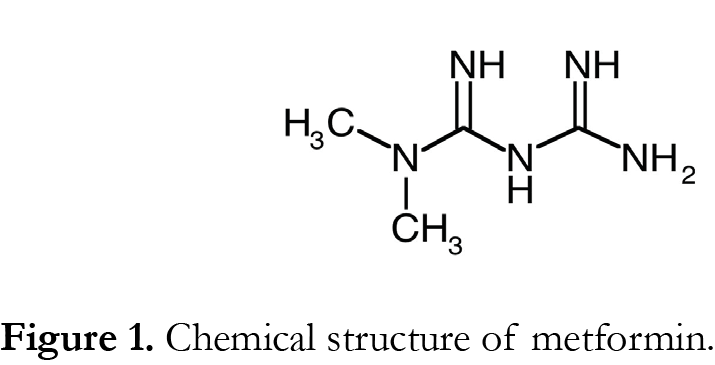

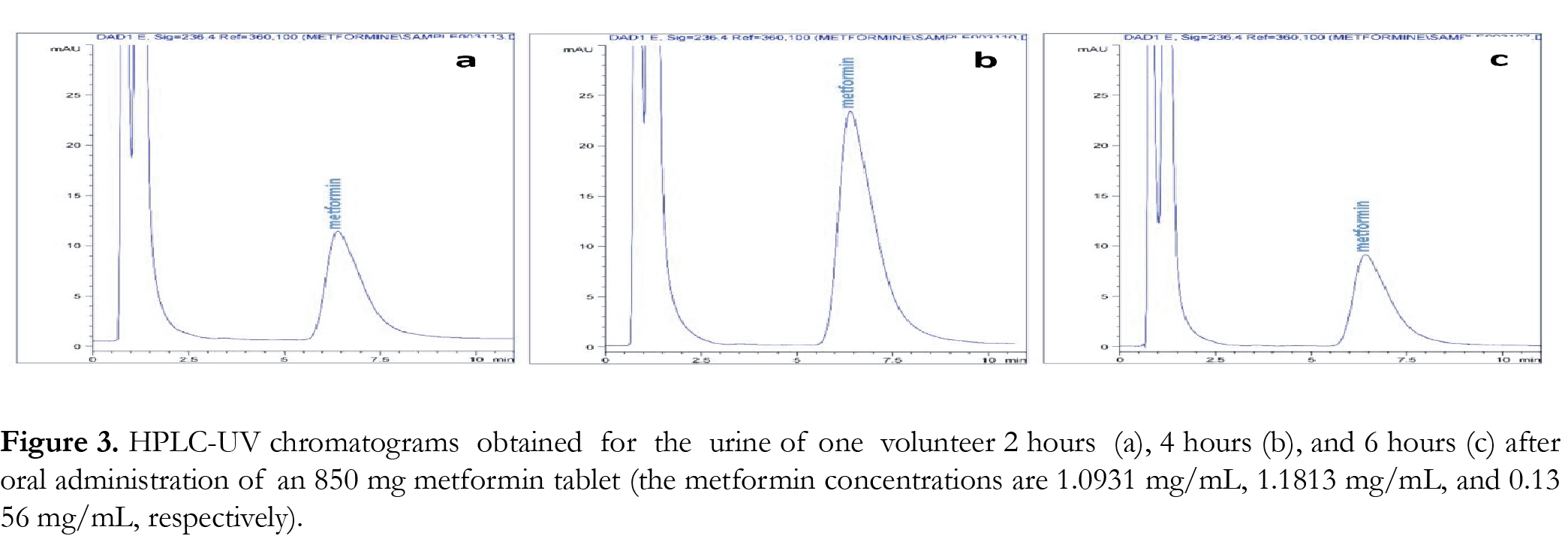
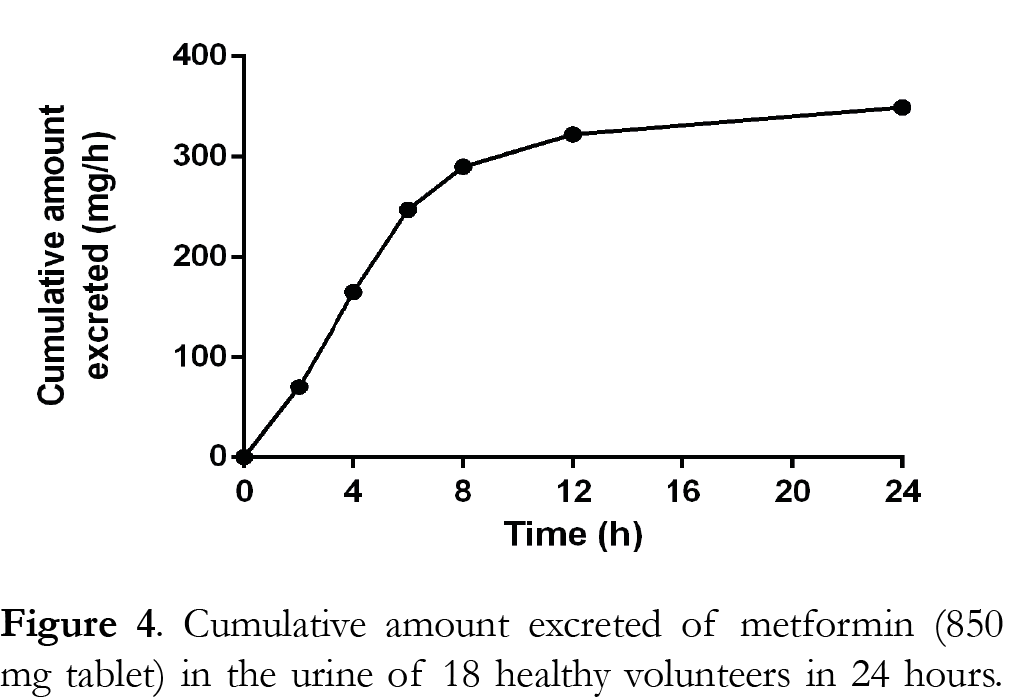
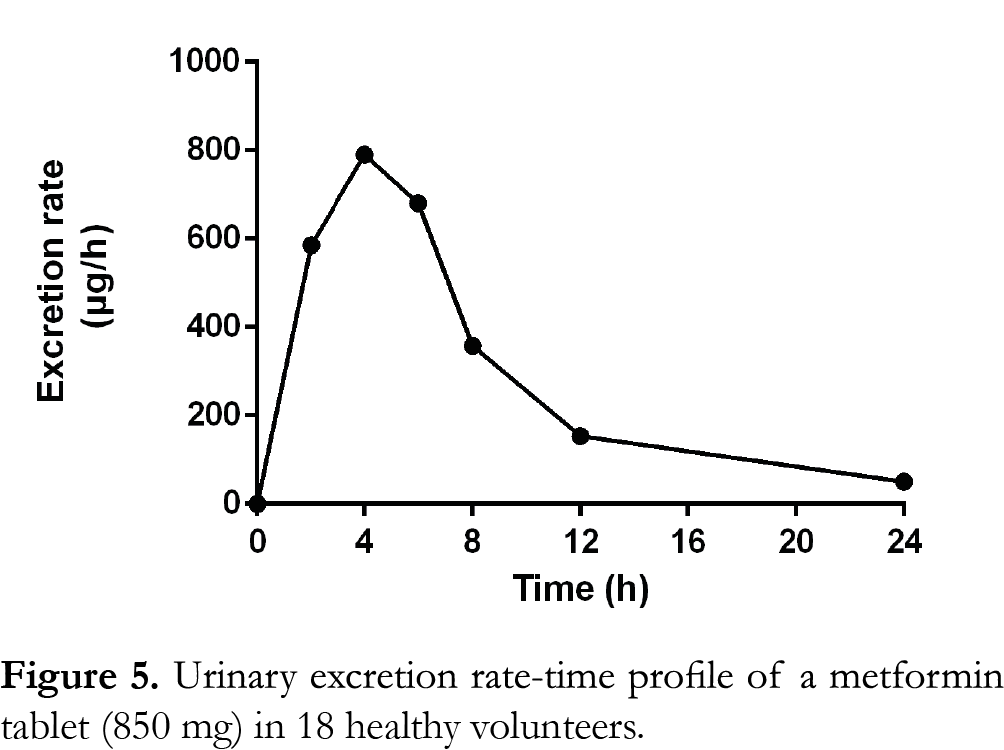
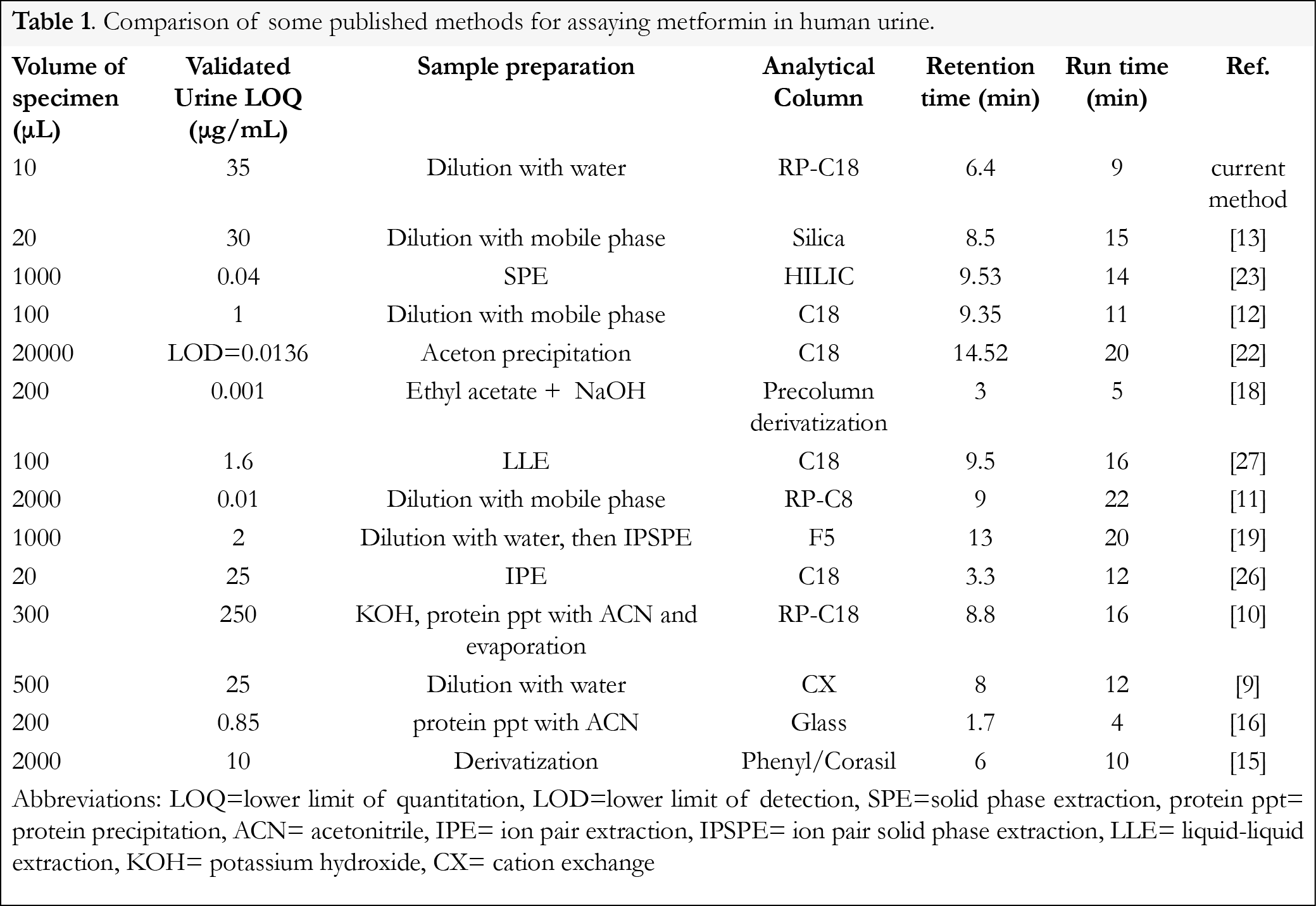

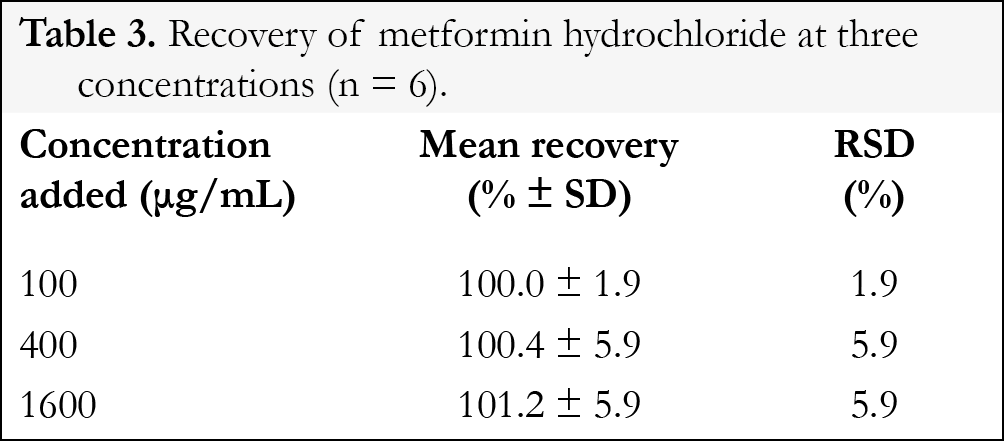
 Open Access Article
Open Access Article Peer-reviewed Article
Peer-reviewed Article Creative Commons Attribution 4.0 License
Creative Commons Attribution 4.0 License 